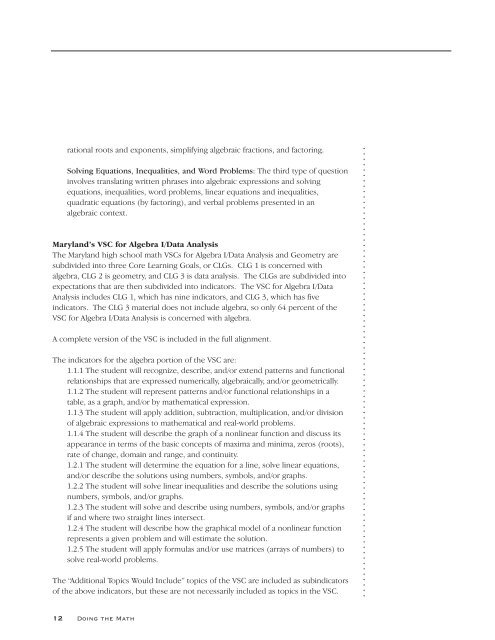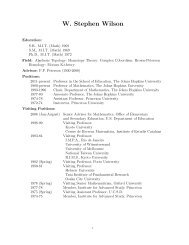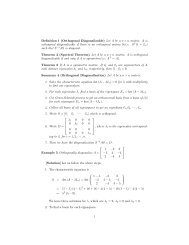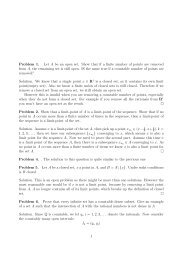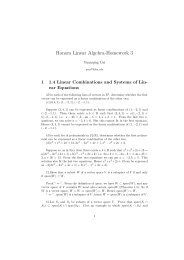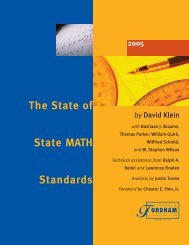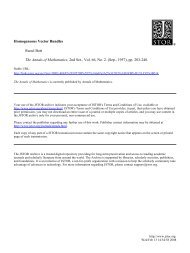Doing the Math - JHU Mathematics - Johns Hopkins University
Doing the Math - JHU Mathematics - Johns Hopkins University
Doing the Math - JHU Mathematics - Johns Hopkins University
You also want an ePaper? Increase the reach of your titles
YUMPU automatically turns print PDFs into web optimized ePapers that Google loves.
ational roots and exponents, simplifying algebraic fractions, and factoring.<br />
Solving Equations, Inequalities, and Word Problems: The third type of question<br />
involves translating written phrases into algebraic expressions and solving<br />
equations, inequalities, word problems, linear equations and inequalities,<br />
quadratic equations (by factoring), and verbal problems presented in an<br />
algebraic context.<br />
Maryland’s VSC for Algebra I/Data Analysis<br />
The Maryland high school math VSCs for Algebra I/Data Analysis and Geometry are<br />
subdivided into three Core Learning Goals, or CLGs. CLG 1 is concerned with<br />
algebra, CLG 2 is geometry, and CLG 3 is data analysis. The CLGs are subdivided into<br />
expectations that are <strong>the</strong>n subdivided into indicators. The VSC for Algebra I/Data<br />
Analysis includes CLG 1, which has nine indicators, and CLG 3, which has five<br />
indicators. The CLG 3 material does not include algebra, so only 64 percent of <strong>the</strong><br />
VSC for Algebra I/Data Analysis is concerned with algebra.<br />
A complete version of <strong>the</strong> VSC is included in <strong>the</strong> full alignment.<br />
The indicators for <strong>the</strong> algebra portion of <strong>the</strong> VSC are:<br />
1.1.1 The student will recognize, describe, and/or extend patterns and functional<br />
relationships that are expressed numerically, algebraically, and/or geometrically.<br />
1.1.2 The student will represent patterns and/or functional relationships in a<br />
table, as a graph, and/or by ma<strong>the</strong>matical expression.<br />
1.1.3 The student will apply addition, subtraction, multiplication, and/or division<br />
of algebraic expressions to ma<strong>the</strong>matical and real-world problems.<br />
1.1.4 The student will describe <strong>the</strong> graph of a nonlinear function and discuss its<br />
appearance in terms of <strong>the</strong> basic concepts of maxima and minima, zeros (roots),<br />
rate of change, domain and range, and continuity.<br />
1.2.1 The student will determine <strong>the</strong> equation for a line, solve linear equations,<br />
and/or describe <strong>the</strong> solutions using numbers, symbols, and/or graphs.<br />
1.2.2 The student will solve linear inequalities and describe <strong>the</strong> solutions using<br />
numbers, symbols, and/or graphs.<br />
1.2.3 The student will solve and describe using numbers, symbols, and/or graphs<br />
if and where two straight lines intersect.<br />
1.2.4 The student will describe how <strong>the</strong> graphical model of a nonlinear function<br />
represents a given problem and will estimate <strong>the</strong> solution.<br />
1.2.5 The student will apply formulas and/or use matrices (arrays of numbers) to<br />
solve real-world problems.<br />
The “Additional Topics Would Include” topics of <strong>the</strong> VSC are included as subindicators<br />
of <strong>the</strong> above indicators, but <strong>the</strong>se are not necessarily included as topics in <strong>the</strong> VSC.<br />
12 <strong>Doing</strong> <strong>the</strong> <strong>Math</strong><br />
. . . . . . . . . . . . . . . . . . . . . . . . . . . . . . . . . . . . . . . . . . . . . . . . . . . . . . . . . . . . . . . . . . . . . . . . . . . . . . . . . . . .


